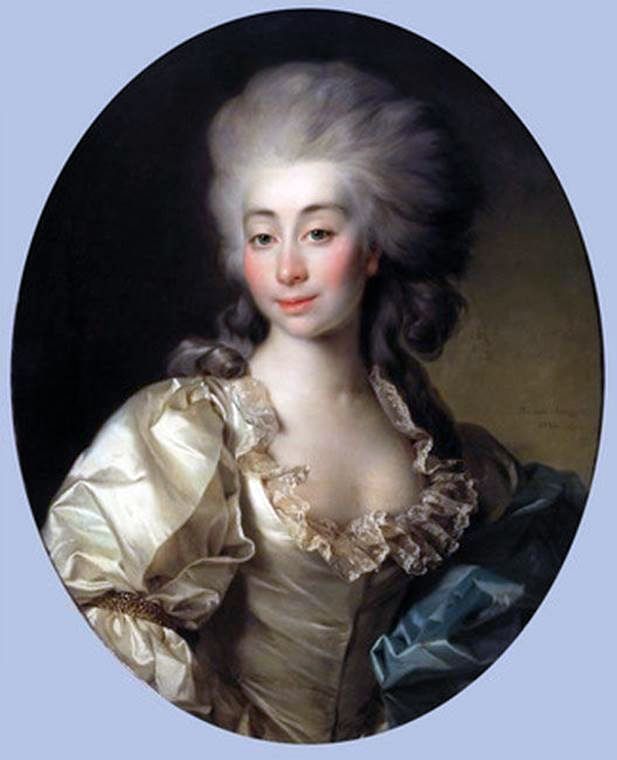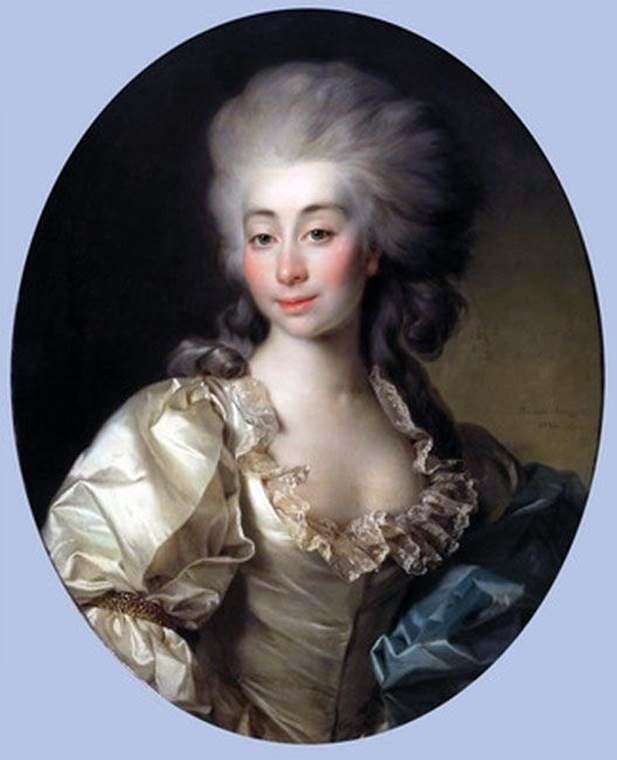
The portrait of Ursula Mnishek was painted at the zenith of the artist’s skill and fame. The oval was rare in the portrait practice of DG Levitsky, however it was this form that he chose for the exquisite depiction of secular beauty. With the full-scale illusiveness, the master conveyed the transparency of the lace, the fragility of the satin, and the gray hair of the fashionable high wig. The cheeks and cheekbones “burn” with the heat of the applied cosmetic blush. The face is written in fused strokes, indistinguishable thanks to the transparent lightened glaze and giving the portrait a smooth-lacquered surface. Against a dark background, bluish-gray, silver-ash and golden-pale tones are advantageously combined.
A distant turn of the head and a kindly-learned smile give the face a polite, secular expression. The cold straight look seems evasive, hiding the inner “I” of the model. Her bright open eyes are deliberately secretive, but not mysterious, as in the best portraits of F. S. Rokotov. This woman, apart from her will, is admired, as well as the masterly masterful painting. Ursula Mnishek by birth belonged to the highest circle of the aristocracy. She is the daughter of Polish governor Jan Zamoyski and Ludwig Poniatowska, sister of the last Polish king Stanislav Poniatowski. In the first marriage – Pototskaya. In 1781 she married Mikhail Mnishek, a Lithuanian court marshal. She was the maid of honor of Catherine II, later a cavalier lady of state. Ursula Mnishek was not only a secular lioness, but also a woman, by the standards of her society, educated.
Distinguished by a fair amount of reading and intelligence, Mnishek was fond of art and beautifully painted, left a very ironic and full of magnificent portrait characteristics memoirs, where Catherine II appears as an actor playing her role in the theater; and she herself is a pampered, strong-willed and domineering beauty, able to restrain her feelings in a court atmosphere. The portrait has long been owned by the Mnishek family. In 1908, in Paris, at the sale of the clan assembly, he was bought by Evfimia Pavlovna Nosova, who by birth belonged to the famous merchant family Ryabushinskys. In 1917, after the February Revolution, Nosova transferred her entire collection to the Tretyakov Gallery for temporary storage, including a portrait of DG Levitsky.
 Portrait d’Ursula Mnishek – Dmitry Levitsky
Portrait d’Ursula Mnishek – Dmitry Levitsky Retrato de Ursula Mnishek – Dmitry Levitsky
Retrato de Ursula Mnishek – Dmitry Levitsky Portrait of G. Levitsky. K (father of the artist) by Dmitry Levitsky
Portrait of G. Levitsky. K (father of the artist) by Dmitry Levitsky Portrait of the priest Peter Levitsky by Dmitry Levitsky
Portrait of the priest Peter Levitsky by Dmitry Levitsky Portrait of D. Didro by Dmitry Levitsky
Portrait of D. Didro by Dmitry Levitsky Portrait of A. Ya. Levitskaya by Dmitry Levitsky
Portrait of A. Ya. Levitskaya by Dmitry Levitsky Portrait of E. N. Khrushchova and E. N. Khovanskaya (Smolyanka) by Dmitry Levitsky
Portrait of E. N. Khrushchova and E. N. Khovanskaya (Smolyanka) by Dmitry Levitsky Portrait of Countess A. S. Protasova by Dmitry Levitsky
Portrait of Countess A. S. Protasova by Dmitry Levitsky